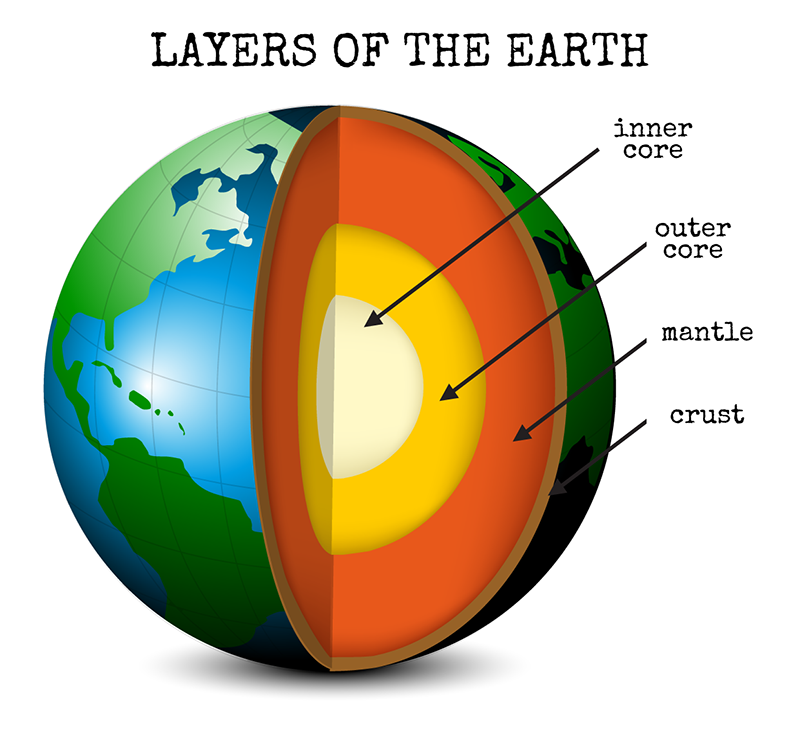
What is a Layer?
Formed billions of years ago, the planet comprises of several layers making the structure of the earth. A layer is defined as the thickness of a material that is laid out. In the case of the earth, these layers are composed of mostly rock and iron. Each layer has its own characteristics and purpose. The four layers of earth include:
- Crust
- Mantle
- Outer Core
- Inner Core
Layers of the Earth
Structure of the Earth: What is Crust Layer?
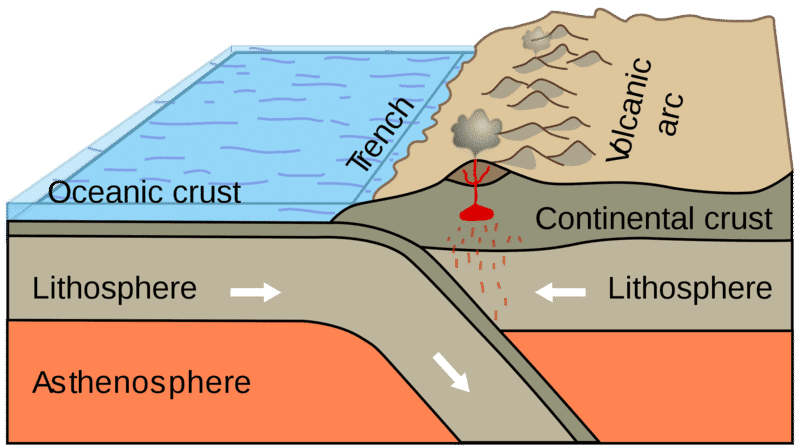
The surface of the earth is known as the crust, which is made of an incredible assortment of rocks that react in different manners and at shifting rates to Earth-molding forms. The outside layer is the main segment of the lithosphere of which scientists and researchers have direct information, even though its surface materials make just about 1% of Earth’s planetary mass. The crust layer creates the external surface of the lithosphere, what’s more, it is of essential significance in understanding the structure of landforms. The thickness of the crust layer is fundamentally lower than that of the core and mantle. It varies from 2.7 to 3.0 grams per cubic centimetre. Compared to the size of the earth, the crust layer is immensely slim.
Location of Ocean and Continental Layers
What are the kinds of Crust Layer?
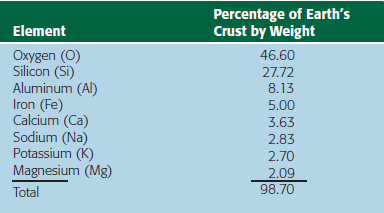
Oceanic and continental crust are two kinds of crusts which are recognized by their thickness, rock composition and placement. The thickness of the crust fluctuates from 3 to 5 kilometres in the ocean basin while the crust under mainland mountain systems is about 70 kilometres thick. The average thickness of the mainland crust is about 32 to 40 kilometres. When compared to the mantle layer, the crust is comparatively hard, frangible and cold. It reacts to pressure by breaking, wrinkling, and raising or bringing down rocks upwards or downwards. Composition of minerals in the crust
What is the Oceanic Crust layer?
Oceanic crust layer comprises of heavy iron-rich rocks which are dark in colour and also contain significant amounts of silicon and magnesium. The thickness of the oceanic crust is very thin relative to the continental crust. The density of the oceanic crust layer is (3.0 g/cm³) which is higher than the density of the continental crust layer (2.7 g/cm³). Basaltic rocks are the most habitual rocks on the planet and they form these gigantic ocean crusts.
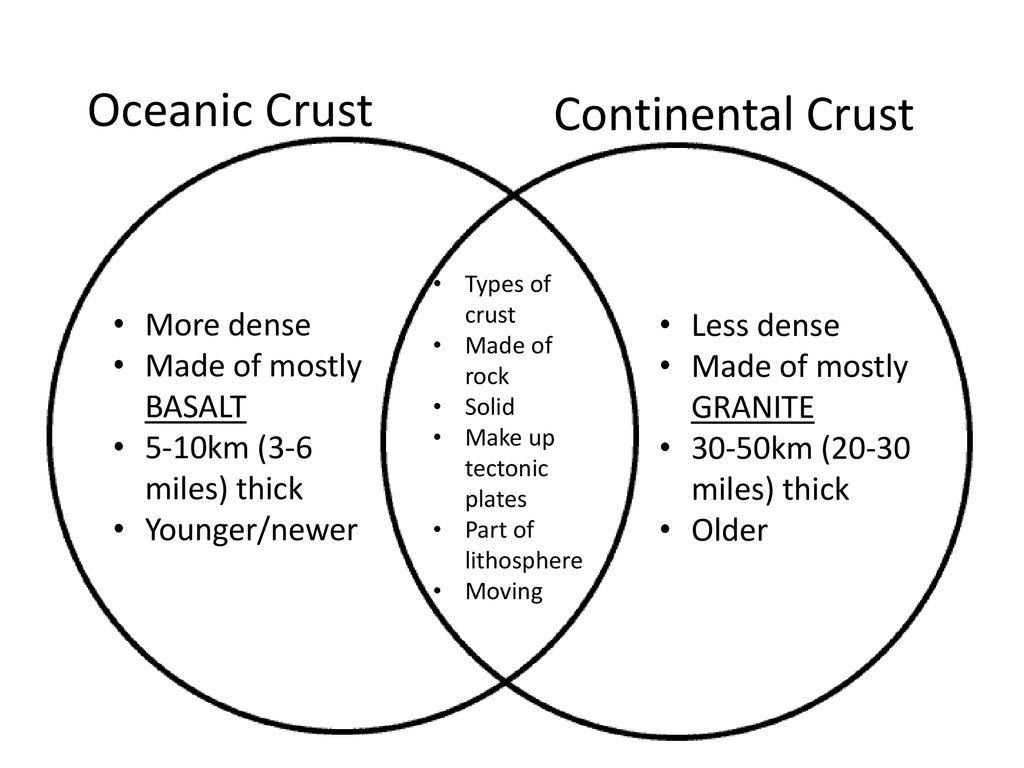
What is Continental Crust Layer?
The continental crust layer includes the significant landmasses on Earth that are revealed to the environment. The density (2.7 g/ cm³) is lower than the oceanic crust however, the continental layer is far more thicker than the oceanic crust. The continental crust reaches high levels of elevation such mountains and it extends to great depths beneath the surface as well. The continental crust mainly comprises of granite; rocks which have a much lighter colour than rocks in the ocean crust.
Difference Between Ocean and Continental Crust
What is Mantle Layer?
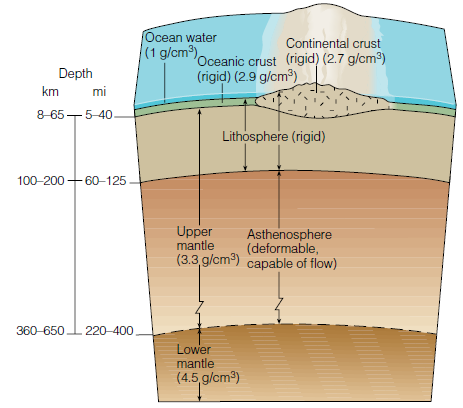
The mantle layer is the largest layer of the earth. It has a thickness of around 2886 kilometres and it constitutes about 66% of the mass of earth. Seismic tremor waves that pass through the mantle show that it is made out of strong rough material, as opposed to the molten outer core that lies underneath it. It is likewise less dense than the core, with values running from 3.3 to 5.5 grams per cubic centimetre). Even though most of the mantle is strong, the material close to the highest point of the mantle particularly shows attributes of a plastic solid, implying that the strong stone material can twist and stream gradually, currently at the pace of a couple of centimetres each year.
The diagram shows the details of lithosphere and asthenosphere
What is it Composed of?
Researchers concur that the mantle comprises of silicate rocks (high in silicon and oxygen) that likewise contain extraordinary measures of magnesium and iron. The mantle is made out of different layers recognized by various qualities of solidarity and unbending nature. Our interest lies in the two highest layers. The furthest layer of the mantle, with a normal thickness of around 100 kilometres, acts like a versatile solid. This is different from the plastic strong conduct of the material in the following lower mantle layer. Versatile solids are unbending and fragile. They try not to stream, yet rather withstand a specific sum of applied pressure (power per unit zone) with little twisting until an edge breaking point of pressure is reached. When it reaches the breaking point, versatile solids are broken. The furthest layer of the mantle has a chemical composition like the remainder of the mantle, yet it reacts to applied pressure like the overlying Earth layer, the crust. Together, the highest mantle layer and the crust create a unit called the lithosphere.
What is Lithosphere?
The term lithosphere has customarily been utilized to portray the whole Earth. In late decades, be that as it may, the term lithosphere has additionally been utilized in a different sense to allude to the fragile external shell of Earth, including the crust and the unbending, highest mantle layer. Stretching out down from the base of the lithosphere around 600 kilometres more distant into the mantle is the asthenosphere, a thick layer of plastic mantle material. The material in the asthenosphere can stream both vertically what’s more, on a level plane, hauling portions of the overlying, unbending lithosphere alongside it. Many Earth researchers now accept that the energy for tectonic forces, enormous scale powers that break and disfigure Earth’s crust, resulting in the formation of quakes and mountain building. It originates from development inside the plastic asthenosphere. Development in the asthenosphere, thus, is delivered by warm convection flows that happen in the rest of the mantle underneath the asthenosphere, and which are driven by heat from rotting radioactive materials in the planet’s internal layers.
What is Mohorovicˇic’ discontinuity?
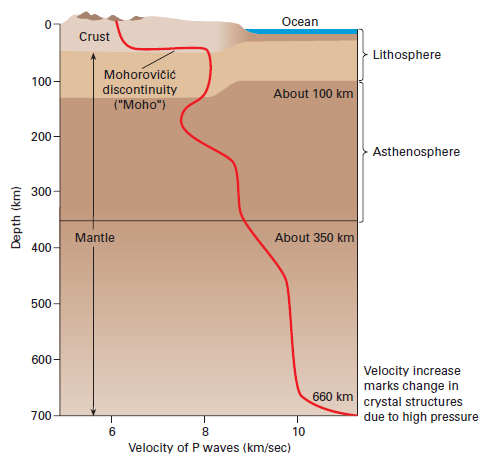
The interface between the mantle and the overlying outside layer is set apart by a critical difference in thickness, called a discontinuity, which is demonstrated by a sudden increment in the speed of seismic waves as they travel down through this interior limit. Researchers call this zone the Mohorovicˇic’ discontinuity, or Moho for short, after the Croatian geophysicist who previously distinguished it in 1909. The Moho doesn’t lie at a steady depth yet, for the most part, reflects the surface geography, being most profound under mountain ranges where the outside layer is thick and ascending to inside 8 kilometres of the seafloor. No geologic boring has yet entered through the Moho into the mantle, however, a global logical organization, called the Integrated Ocean Drilling Program, is taking a shot at such a venture. Rock tests in the long run recovered from cores penetrated through the Moho will add incredibly to our comprehension of the organization and structure of Earth’s lithosphere.
The figure shows details regarding Mohorovicˇic’ discontinuity
What is the Core Layer?
This is comprised of two layers, the internal and the external center. The Earth was formed 4.5 billion years back, and when this occurred, all the overwhelming materials sunk to the center and this turned into the inner core. The lighter ones like air and water remained on the top of the crust layer.
Earth’s deepest segment, the core, contains 33% of Earth’s mass and has a range of around 3360 kilometres, which is bigger than the planet Mars. Earth’s center is under huge pressure—a few million times atmospheric pressure (in excess of 7 billion millibars). Researchers have reasoned that the center is made basically out of iron and nickel, and comprises of two unmistakable areas, the internal core and the external core.
What is Inner Core?
Earth’s inward center has a range of around 960 kilometres. The speed of P and S waves going through the inner core shows that it is strong with a high material thickness of around 13 grams for each cubic centimetre (0.5 lbs/in³).

What is the outer core?
The outer core structures a 2400-kilometre-thick band around the internal center. Rock matter at the highest point of the external center has a thickness of around 10 grams for every cubic centimetre (0.4 lbs/ in³). Since the external center hinders the section of seismic S waves, Earth researchers realize that the outer core is liquid (softened/fluid-rock). The high thickness of the two segments of Earth’s center reinforces the thought that they are made out of iron and nickel.
The diagram shows the temperature at different levels
Why is the outer core liquid while the inner core is solid?
The appropriate response includes the way that the melting point of minerals depends on temperature as well as on pressure. At the point when rock matter is feeling the squeeze, it liquefies at a higher temperature than when it is encountering a lower pressure. The material of the inner core is feeling the higher pressure than the rock matter in the outer core. Because of this extraordinary weight, the material in the inner core stays solid at a high temperature. Temperatures in the outer core are lower than in the internal center, yet pressures are lower there too, and this causes the external center material to exist in the liquid state. Inside temperatures are assessed to be 6000°C (11000°F) at the focal point of Earth diminishing to 3000°C (5400°F) at the highest point of the outer core.
Amazing Facts about the layers of the earth.
- The focal point of the Earth is the core, which is for the most part iron and nickel. The inner core is strong and measures 1,516 miles in breadth.
- The outer core of the Earth is fluid metal – likewise for the most part nickel and iron. Together, they are about as huge as Mars. The external centre is 1,408 miles in measurement.
- Meteors regularly contain bits of nickel and iron. Researchers accept they might be pieces from different planets that detonated.
- The mantle of the Earth is a strong stone, however, it’s not totally hard. In light of the extreme warmth, the mantle is pliable, similar to the play mixture. The mantle gradually moves. This development causes quakes and volcanic ejections.
- The mantle is 1,800 miles down.
- The outer layer of the earth rotates to create a magnetic field around the earth, like a bubble.
- The outside layer of the Earth is made of rock and other strong stones. Sand, soil and squashed stone sit on the outside layer. The outside layer goes top to bottom from 3 to 43 miles.
- In the past there was only one big continent (continental layer), but with the passage of time, it broke into pieces are spread across the globe.
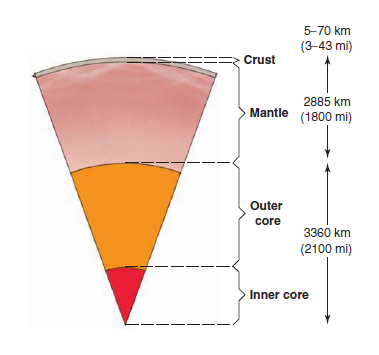
Summary
I In conclusion, the earth consists of four layers; crust, mantle, outer core and inner core. Each layer has its own chemical composition and way of operation. The crust is the uppermost layer of the earth while the inner core is the center point of the earth. Crust mainly comprises rocks which are very common. The mantle, however, is molten and moves gradually, this layer is the biggest of all four layers with the crust being the smallest. The outer core is a molten liquid that puts high pressure on the inner core. Due to this high pressure, the inner core remains in a solid state.
Earthquakes are the result of movement in these layers. Scientists from all around the world used seismic waves to study the structure of these layers. They even drilled holes into the ground to visually confirm their scientific theories. The temperature increases as the depth increase so the inner core has the highest temperature while the crust has the lowest. The outer core of the earth is rotating since it is in the molten iron state. This rotation creates a magnetic field that protects the earth from the sun’s strong solar winds.
A fun fact
The deepest hole ever dug in the earth is located in Kola Peninsula, east of Scandinavia. The diameter of the hole was about 9 inches however the depth reached 40,230 feet. It took almost 20 years to drill this hole and scientists found some incredible things along the way such as Plankton fossils.
Read more about Plate Tectonics
Frequently Asked Questions
What are the Earth’s major layers?
The Earth is composed of four major layers: the inner core, outer core, mantle, and crust, each with distinct properties and composition.
How is the Earth’s crust different from the mantle?
The crust is the outermost layer and is composed of solid rock, while the mantle lies beneath and is semi-solid, capable of slow-flowing movement.
What causes tectonic plate movement within the Earth’s structure?
Tectonic plate movement is driven by convection currents in the semi-fluid mantle, leading to the drifting of continents, earthquakes, and volcanic activity.
How does the Earth’s magnetic field relate to its structure?
The Earth’s magnetic field is generated by the movement of molten iron in the outer core, creating a protective shield around the planet.
How does knowledge of the Earth’s structure impact scientific understanding and exploration?
Understanding the Earth’s layers helps explain geological processes, and earthquake behaviour, and provides insights into the planet’s history.
References (Images)
- Layers of the earth. (n.d.). [image] Available at: https://i.pinimg.com/originals/35/a6/42/35a6425d232fd095ec0236c7baeb4b5b.png [Accessed 7 Feb. 2020].
- cclark001 (2012). 8 3.1 layers of the earth. [image] Available at: https://www.slideshare.net/cclark001/8-31-layers-of-the-earth [Accessed 7 Feb. 2020].
- J. Green, “Geotechnical Table of the Elements for 1953,” Bulletin of the
- Geological Society of America 64 (1953).
- Brooks/cole cencage learning (2009). A cross section of the lithosphere, asthenosphere, and lower mantle. [image] Available at: http://Physical Geography 9th edition [Accessed 7 Feb. 2020].
- Brooks/cole cencage learning (2009). Velocity of seismic P (primary) waves in the crust and upper mantle. [image] Available at: http://Physical Geography 9th edition [Accessed 7 Feb. 2020].
- Discover magazine (2014). Taking the Temperature of Earth’s Core. [image] Available at: https://www.discovermagazine.com/planet-earth/taking-the-temperature-of-earths-core [Accessed 7 Feb. 2020].
- Brooks/cole cencage learning (2009). Cross section through Earth’s internal structural zones. [image] Available at: http://Physical Geography 9th edition [Accessed 7 Feb. 2020].
